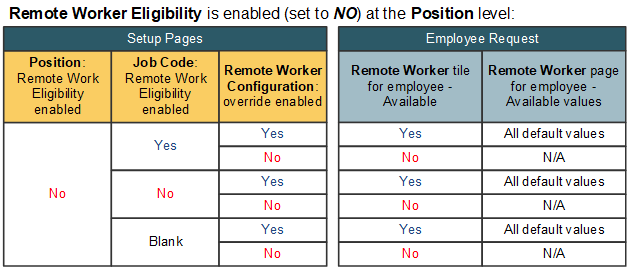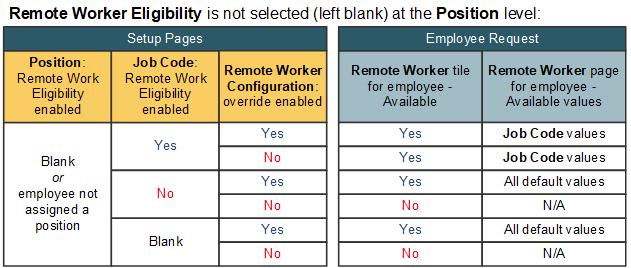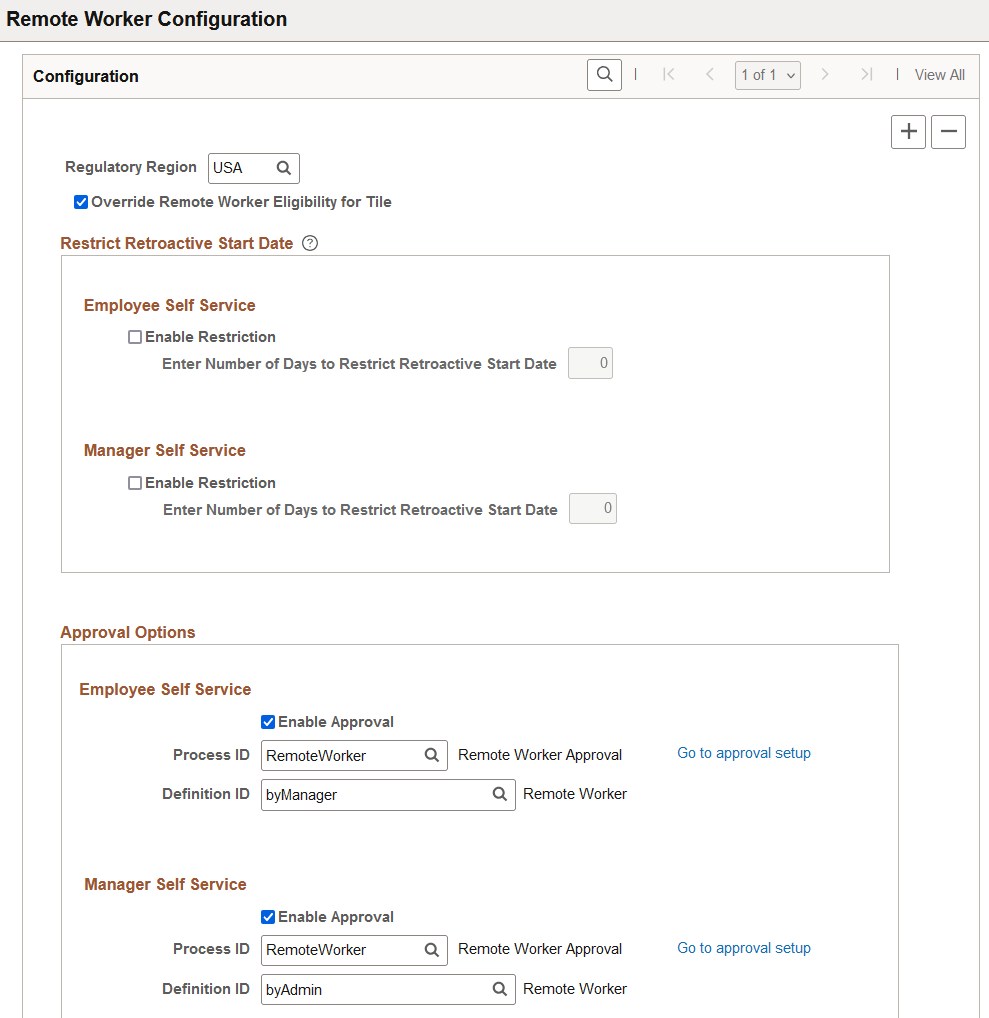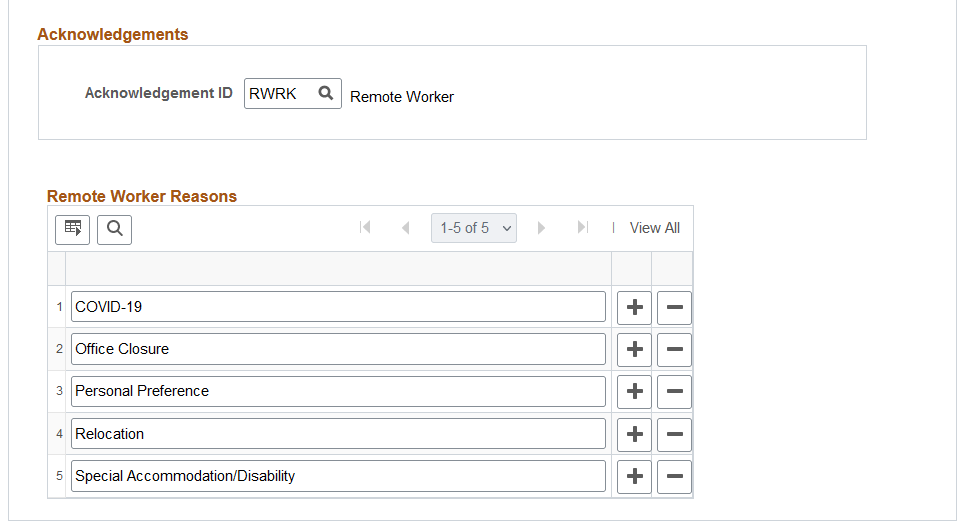Setting Up Remote Worker Configurations for Fluid
With remote work becoming more common for many organizations, the Fluid Remote Worker functionality in Human Resources enables you to track jobs and positions eligible for remote work as well as workers that work remote. This information is also useful for U.S. customers that may base local or state tax based on a person's typical work location.
Remote Worker functionality uses the following frameworks to deliver a robust method of recording and tracking remote work:
Configurable Search
Activity Guide Composer
Acknowledgement Framework
Questionnaire Framework
Attachments/Notes
Approvals
To configure Fluid Remote Worker installation settings and capabilities, use the Remote Worker Configuration (HR_RW_CONFIG) component.
These videos provide an overview of the Fluid Remote Worker feature:
Video: Image Highlight, PeopleSoft HCM Update Image 40: Remote Worker
Video: PeopleSoft Remote Worker
This topic lists prerequisites to using the Remote Worker feature and discusses configuring the Fluid Remote Worker functionality.
|
Page Name |
Definition Name |
Usage |
|---|---|---|
|
HR_RW_CONFIG |
Define remote work settings by regulatory region, including the eligibility override, retroactive request settings for managers and employees, approval options, and reasons for working remote. |
Before you can use the Fluid Remote Worker functionality for your employees and contingent workers, you must:
Define the remote worker configurations for each regulatory region that allows remote work on the Remote Worker Configuration Page.
Assign remote worker roles to the users.
Use the following roles and configurations to grant access to the tiles and pages on the following homepages:
Access
Role
Additional Configuration
Employee Self Service homepage > Remote Worker Tile (for Employees)
Fluid Remote Worker Employee
The tile will only appear on the Employee Self Service homepage when at least one of the following is in place:
The employee's position is eligible for remote work.
The employee's position eligibility is not defined (left blank) and the employee's job code is eligible.
The Remote Worker Configuration settings override the position or job eligibility settings.
Manager Self Service homepage > Remote Worker Tile (for Managers)
Fluid Remote Worker Manager
Workforce Administrator homepage > Remote Worker Tile (for Administrators)
Fluid Remote Worker Admin
Note: When granting the manager or administrator roles, the corresponding tiles will automatically appear on the correlating homepage.
Identify if jobs and positions are eligible for remote work.
When the remote work eligibility is enabled for either the job or position, the Employee Self Service homepage will display the Remote Worker Tile (for Employees) when the employee has the Fluid Remote Worker Employee role and certain eligibility rules are met.
Define the Remote Work Eligibility option on the following pages:
To indicate that a job is available for remote work:
Job Code Table - Job Code Profile Page.
To indicate that a position is available for remote work:
If you do not configure the job code or position Remote Work Eligibility settings (leave it blank), the system may still use other settings to consider an employee eligible to request remote work (see the Understanding Remote Work Eligibility for Employee Requests topic that follows).
Important! Remote work eligibility can be defined for the job code as well as position. When remote work eligibility is defined for both the employee's job code and position, the position always takes precedence.
There are many factors that are taken into consideration when determining if an employee can submit a request for remote work. The system uses the remote worker eligibility configurations on the following pages to determine eligibility and valid remote work types for employee-submitted requests:
Job Code Profile Page: Remote Work Eligibility settings
Manage/Create Position - Position Data Page: Remote Work Eligibility settings
Remote Worker Configuration Page: Override Remote Worker Eligibility for Tile check box
While organizations can use the job code and position to define if remote work and types (fully remote or hybrid) are eligible for jobs or positions, the Remote Worker Configuration page enables you to override those settings.
Rules Driving Remote Work Eligibility for the Employee
Although there are many rules that drive the remote worker eligibility for an employee request, they can be categorized into three groupings bases on the Position configurations. These tables show employee remote worker eligibility (remote worker tile accessibility and type values) when the following settings are in place and the employee has been granted the Fluid Remote Worker Employee role:
Note: These rules are used for employee requests. They are not used for manager and administrator requests.
The system uses the following settings when a Position is eligible for remote work.

The position generally drives most of the eligibility for employee remote work requests. When position eligibility is set to YES, the employee will have access to the tile and request pages.
The employee will be able to submit requests using the position configured remote worker types (Fully Remote and/or Hybrid), despite the job code or override settings. If remote worker types were not defined at the position level and the eligibility was set to YES, all Remote Worker Types will be available by default to the employee when entering a request.
The system uses the following settings when a Position is not eligible for remote work.

When the position eligibility is set to NO, the employee will have access to the Remote Worker tile and request pages only if the Override Remote Worker Eligibility for Tile is enabled on the Remote Worker Configuration.
The Remote Worker request pages will show the default Remote Worker Type values (Fully Remote and Hybrid). Since the position overrides the job code, and the position is set to NO, the system does not consider the job code settings.
With the position set to NO (not eligible) and the override not selected, the employee does not have access to the tile, making the remote worker types not applicable (N/A), since he or she cannot access the tile to make the request.
The system uses the following settings when a Position has not been configured for remote work eligibility.

When a position's remote work eligibility has not been configured and left blank or the employee is not assigned a position, the employee will have access to the tile if his or her job code is eligible OR the override setting has been enabled on the Remote Worker Configuration page. While the position typically takes precedence, with eligibility not defined, the job code is considered.
When remote work eligibility for the employee's position is not define (blank) but the job code is eligible (YES), the system will display the job code Remote Worker Type values during the request. If specific types were not identified at the job code level, all values (Fully Remote and Hybrid) will be available to the employee when entering a request.
If the job code is not eligible (NO) or its eligibility is not defined (blank), the override setting must be enabled in order for the employee to access the Remote Worker tile and request pages. In these cases, the Remote Worker Request pages will show the default Remote Worker Type values (Fully Remote and Hybrid).
With the position settings not defined (left blank), the job code set to NO (not eligible) or defined (left blank), and the override not selected, the employee does not have access to the tile, making the remote worker types not applicable (N/A), since he or she cannot access the tile to make the request.
Examples of Remote Work Type Eligibility
The following are examples of how the system determines what remote work types an employee can select based on the job code, position, and remote work configuration settings.
|
Scenario |
Manage/Create Position - Position Data page |
Define Job Code - Job Code Profile page |
Remote Worker Configuration page, Override Remote Worker Eligibility for Tile check box |
Employee's remote work request allows: |
|---|---|---|---|---|
|
1 |
Employee not assigned a position |
Eligible: YES Type: Fully Remote |
Selected |
Employee can select only Fully Remote |
|
2 |
Eligible: YES Type: Hybrid |
Eligible: YES Type: Fully Remote Type: Hybrid |
Selected |
Employee can select only Hybrid |
|
3 |
Eligible: NO |
Eligible: YES Type: Hybrid |
Selected |
Employee can select either Fully Remote or Hybrid |
|
4 |
Eligible: YES Type: Hybrid |
Eligible: NO |
Selected |
Employee can select only Hybrid |
Note: In all scenarios, the Override Remote Worker Eligibility for Tile option is selected on the Remote Worker Configuration Page.
Scenario 1: The employee is assigned to a job code that allows employees to work Fully Remote but not Hybrid. The employee is not assigned to a position.
When the employee enters a request, he will be able to select only the Fully Remote option based of the job code settings.
Scenario 2: The employee is assigned to a job code that allows employees to work Fully Remote AND Hybrid. The employee is assigned to a position that allows only Hybrid remote work.
When the employee enters a request, she will be able to select only the Hybrid option, because the position takes precedence over the job code.
Scenario 3: The employee is assigned to a job code that allows employees to work Hybrid but not fully remote. The employee is assigned to a position that does not allow remote work.
When the employee enters a request, he will be able to select either Fully Remote or Hybrid, because the override option is selected on the Remote Worker Configuration page and the system uses the default remote worker types.
Scenario 4: The employee is assigned to a job code that does not allow remote work. The employee is assigned to a position that allows only hybrid remote work.
When the employee enters a request, she will be able to select only the Hybrid option based on the position settings, because the position takes precedence over the job code.
Use the Remote Worker Configuration page (HR_RW_CONFIG) to define remote work settings by regulatory region, including the eligibility override, retroactive request settings for managers and employees, approval options, and reasons for working remote.
Navigation:
This example illustrates the fields and controls on the Remote Worker Configuration page (1 of 2).

This example illustrates the fields and controls on the Remote Worker Configuration page (2 of 2).

|
Field or Control |
Description |
|---|---|
|
Regulatory Region |
Enter the regulatory region to which these remote worker settings apply. To add additional regulatory regions, insert a new row. |
|
Override Remote Worker Eligibility for Tile check box |
Select this check box to override any job code or position eligibility settings. This enables the Remote Worker tile on the Employee Self Service homepage for employees that have the Fluid Remote Worker Employee role, even if their job or position is not eligible for remote work. When you deselect this option, the employee tile will only appear for those who have the role and whose:
See also the Understanding Remote Work Eligibility for Employee Requests to understand the role of the override option. |
Restrict Retroactive Start Date
Use this section to determine how far back an employee or manager can enter a remote worker request for an employee.
|
Field or Control |
Description |
|---|---|
|
Employee Self Service - Enable Restriction check box Manager Self Service - Enable Restriction check box |
Select this option for the employee, manager, or both to prevent the employee, or manager on the employee's behalf, from entering a remote worker request with start date beyond the number of days entered Note: The restriction does not apply to the first remote work request. The restriction comes into effect only from second request onwards. |
|
Enter Number of Days to Restrict Retroactive Start Date |
This option becomes available for the Employee Self Service or Manager Self Service when you select the corresponding Enable Restriction check box. For the Employee Self Service section, enter the number of days an employee can retroactively enter a remote worker request for them self. For the Manager Self Service section, enter the number of days a manager can retroactively enter a remote worker request for an employee. For example, if the employee option is set to 5 days, and it is the 25th of the month, the employee cannot enter requests prior to the 20th of the month. However, if the manager's days are set to 20, the manager can enter a request for the employee as early as the 5th of the month, but not prior to that. Note: The restriction does not apply to the first remote work request. The restriction comes into effect only from second request onwards. |
Approval Options
Use this section to configure approval related information for Fluid Remote Worker. You can indicate if approval is needed for the employee (Employee Self Service) or manager (Manager Self Service) to submit a remote work request.
Note: Approvals need to be enabled to use this functionality.
|
Field or Control |
Description |
|---|---|
|
Enable Approval |
Select to require approvals for the following:
|
|
Process ID |
The Process ID field is required if you have enabled the approval option. Associate the approval process ID that should be used when making an employee request (Employee Self Service) or making a request on behalf of the employee (Manager Self Service). When you enable the approval check box, the process ID will prepopulated with the RemoteWorker transaction, but you can override this. Note: You can associate the same process ID for the employee or manager approval options. If you enter your own approval process definition ID for creating a new row or for updating existing data, you will also need to update the Approval Process definition (Defining the Setup Process Definitions Component), the Page Composer setup (Understanding Page Composer), and Mobile Approvals options. |
|
Go to approval setup |
Click this link to open a new browser window and access the approval setup Register Transactions Page. You can then view or update the existing registered approval transaction setup for the process ID you entered. When no ID is entered, the system will direct you to the Register Transactions search page where you can review all transaction registries. |
|
Definition ID |
Enter the definition ID to be used to process the approval for either the employee or manager. |
On the submission of a transaction, the approval chain will appear on the following pages:
Remote Worker Request Page, through the Approval Chain column and link.
Status values on this page reflect the statuses as applicable for approvals.
Acknowledgements
|
Field or Control |
Description |
|---|---|
|
Acknowledgement ID |
Enter the ID containing the message catalog entry for remote worker acknowledgement. You create acknowledgement IDs on the Acknowledgement Configuration Page. See also (Employee) Remote Worker Request - Acknowledgement Page. |
Remote Worker Reasons
Enter the valid reasons a person may be allowed to work remote.